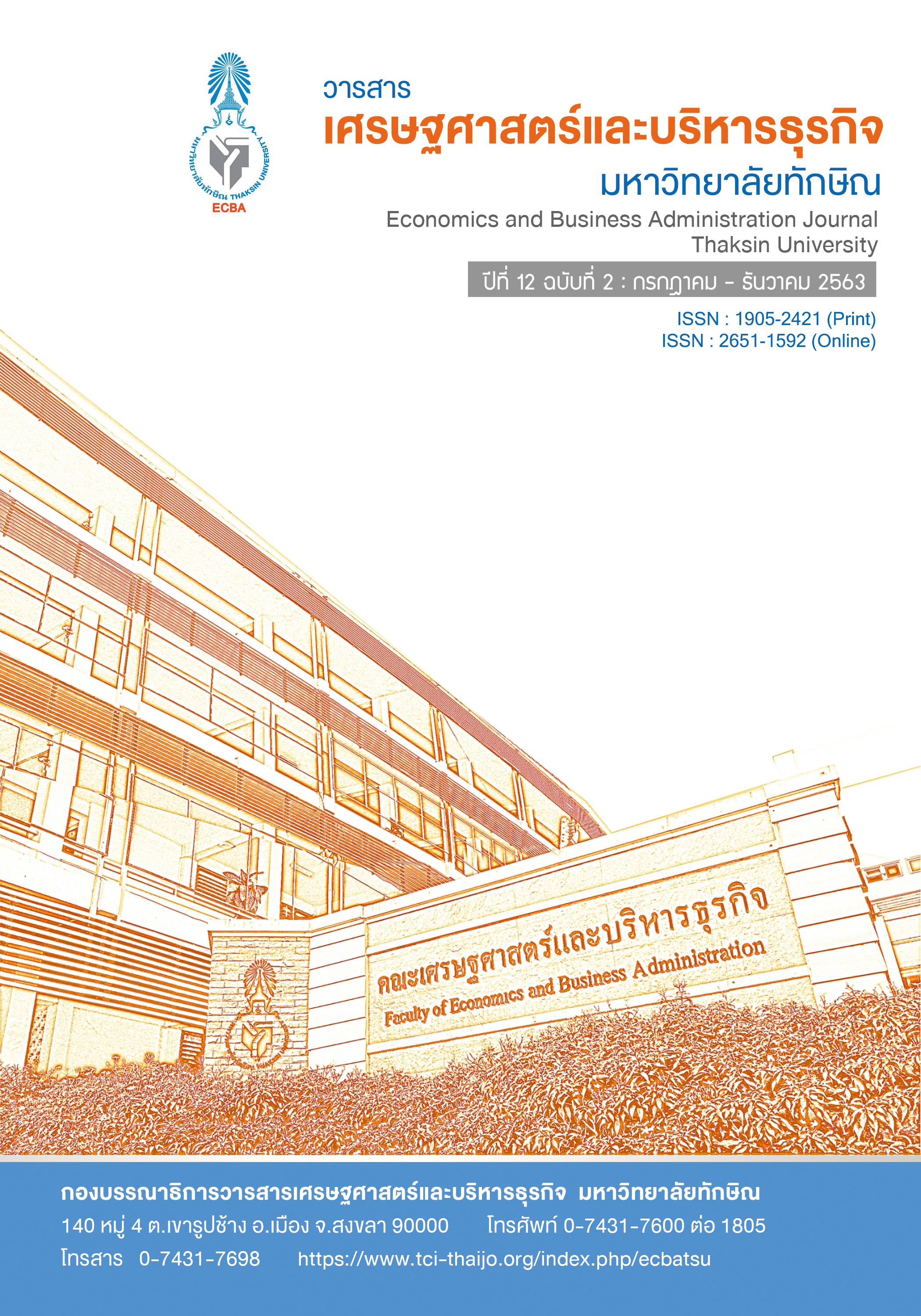A Comparison of News Exposure via Social Media and Print Media of the Students in Mueang District, Songkhla Province
Keywords:
News Exposure, Social Media, Print Media, StudentAbstract
The objectives of this study were to 1) study news exposure via social media of the students in Mueang District, Songkhla Province, 2) study news exposure via print media of the students in Mueang District, Songkhla Province, and 3) compare news exposure via social media and print media of the students in Mueang District, Songkhla Province. Questionnaires were used for data collecting from 402 male and female students in Mueang District, Songkhla Province. Statistics were used for data analysis included descriptive statistics; mean, standard deviation, maximum and minimum, and inferential statistics; regression analysis. The results of the study revealed that 1) factors affecting the students' news exposure via social media were age, salary, product, price and place, the 5 factors affecting 31.80% of the students' news exposure via social media, 2) factors affecting new exposure via print media of the students were salary, price, place and promotion, the 4 factors affecting 26.20% of the students' news exposure via print media, and 3) The comparison of news exposure via social media and print media of the students in Mueang District, Songkhla Province found that the forecasting equation for news exposure via social media had more R2 than the forecasting equation for news exposure via print media 5.60%. The research results will be a way for social media and print media entrepreneurs to penetrate more target groups.
References
Amphawan, S. (2013). Literacy of adolescents’ media exposure behavior in Bangkok. Bangkok: Sripatum University.
Bencharongkit, Y. (1991). Audiences analysis. Bangkok: Chulalongkorn University.
Hunt, T. and Ruben, B. D. (1993). Mass communication: Producer and consumers. New York : Harper College Publishers.
Kittiwat, K. (1988). Communication dynamics. Bangkok: Sukhothai Thammathirat Open University.
Klapper, J. T. (1960). The effects of mass communication. New York : The Free Press.
McCombs, M. and Becker, L. B. (1979). Using mass communication theory. New York : Prentice Hall.
Meelap, J., Tangcharoen, K., Phutthipan, N., Boripunt, W. and Noknoi, C. (2018). Intention to use social media for business. Walailak Procedia. 2018 (1), ss77.
Meenuot, A., Uthaiburom, T., Panthong, R., Duangchuay, A., Sothamet, K., Boripunt , W. and Noknoi, C. (2017). Social media using behavior of people with hearing disabilities in Hat Yai District, Songkhla Province in the 4th TNIAC National Academic Conference on 19 May 2017 at Thai-Nichi Institute of Technology. Bangkok: Thai-Nichi Institute of Technology.
Noknoi, C. (2016). Internal organizational communication: Concepts, theories and applications. Bangkok: Chulalongkorn University Press.
Noknoi, C. (2017). Organizational behavior. Bangkok: Chulalongkorn University Press.
Noknoi, C. and Boripunt, W. (2009). Internet marketing: New opportunities, options and challenges. Journal of Business Administration. 32 (121), 34-52.
Noknoi, C., Boripunt, W. and Ngowsiri, S. (2011). Organizational communication for becoming an autonomous university: The case of Thaksin University. The International Journal of Interdisciplinary Social Sciences. 6(2), 155-166.
Phongspaitoon, D. (2001). Media exposure, knowledge and attitude about sex education of teenagers in Bangkok. Bangkok: Chulalongkorn University.
Rajamangala University of Technology Srivijaya. (2019). Rajamangala’s student statistics, 2019. Retrieved from http://regis2.rmutsv.ac.th/information/statistic.
Songkhla Rajabhat University. (2019). Songkhla Rajabhat’s student statistics report 2019. Retrieved from http://regis.skru.ac.th/RegisWebH5/std_12562/web/stdPage-01.php.
ThaiHealth Promotion Foundation News. (2015). Reading creating happiness, awakening imagination. Retrieved from https://www.thaihealth.or.th/Content/30792.
ThaiQuote. (2019). Alas, Thai children! Less reading, more surfing internet. Retrieved from https://www.thaiquote.org/content/204083
Thaksin University. (2019). Thaksin university’s student statistics system 2019. Retrieved from https://mis.reg.tsu.ac.th/stat.
Thawirat, P. (1997). Construction and development of achievement test. Bangkok: Educational and psychological test bureau, Srinakharinwirot university.
Thepnuan, N. (2015). A study on printed and electronic media reading behaviors among
undergraduate students of the faculty of education, Naresuan university. Journal of Liberal Arts, Prince of Songkla University, Hat Yai Campus. 7 (2), 78-97.
Tungjang, A. (2017). Factors influencing the decision on watching social media program. Master of business administration thesis. Bangkok: Thammasat University.
Wongmontha, S. (1999). Marketing strategy, marketing planning. Bangkok: Tira Film and Citex.
Yamane, T. (1967). Statistics: An introductory analysis. New York: Harper & Row.




